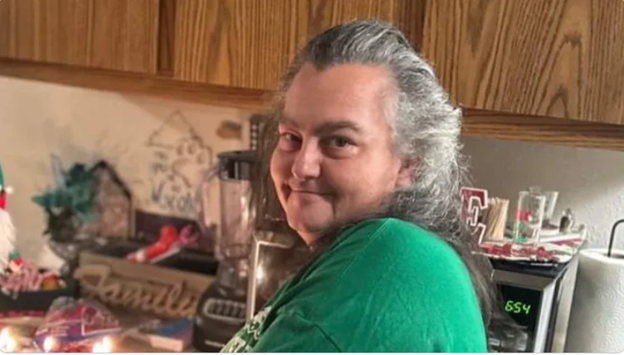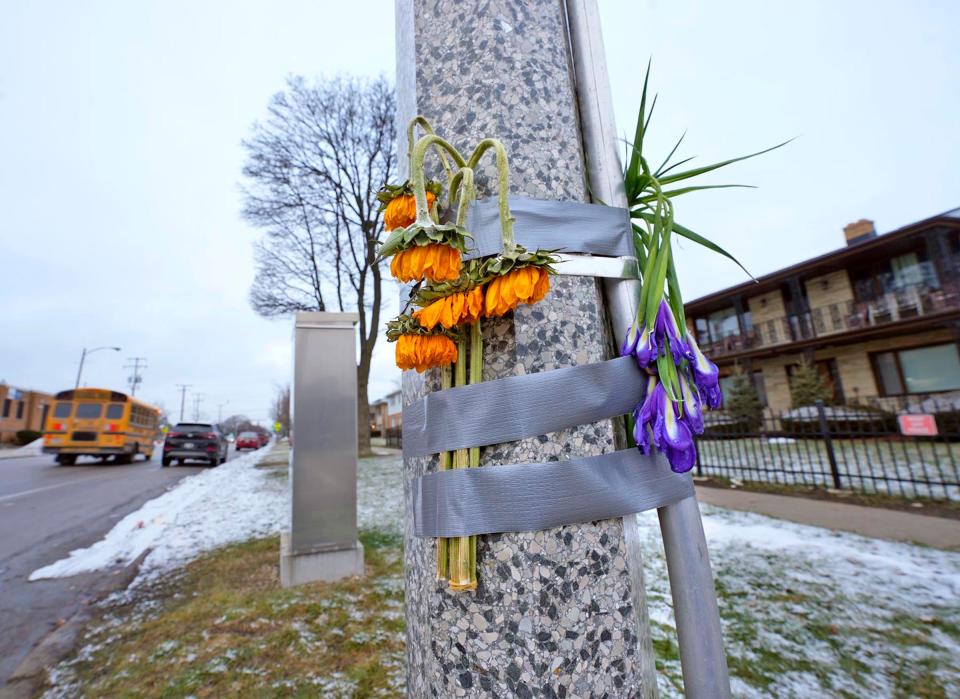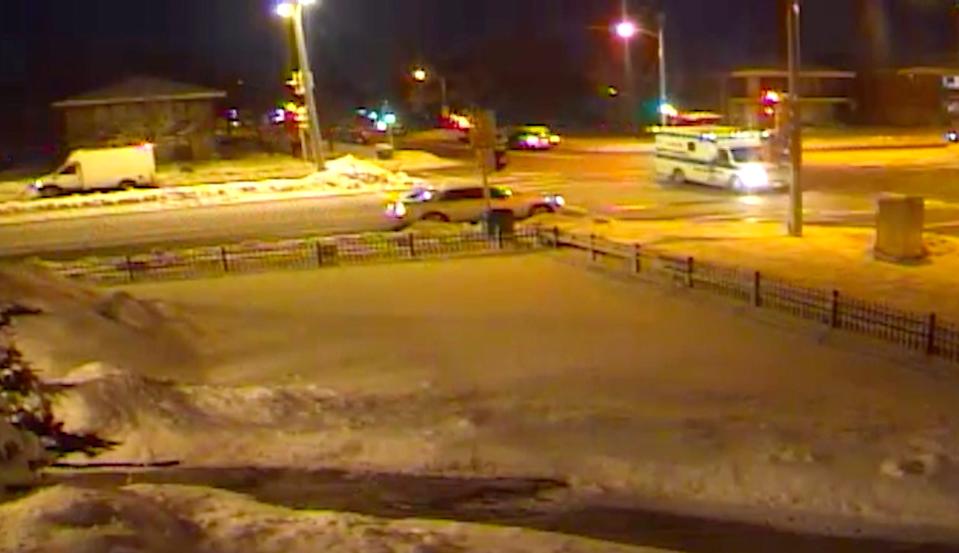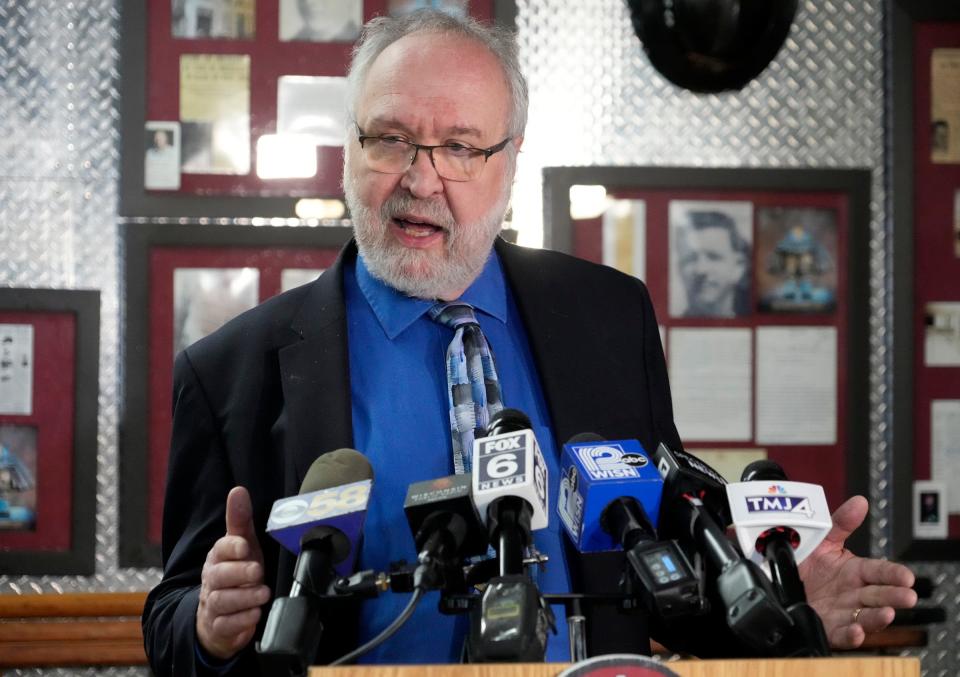Jolene Waldref died at an icy Milwaukee bus stop. Many people had the chance to help her.
When Jolene Waldref called 911 for help in subzero temperatures, she said she couldn’t breathe.
When a dispatcher asked her what happened, Waldref said, “I don’t know.”
More than two weeks after Waldref died near a bus stop at a busy Milwaukee intersection, it remains unclear what kind of emergency she may have experienced — and why so many who could have helped her didn't, until it was too late.
Countless vehicles drove by her as she slipped into a crisis. A county bus pulled up but its driver did not open the door. The ambulance she'd phoned for drove by twice but did not slow to look for her, nor did responders search for her on foot. A pedestrian walked past her as she lay in the snow, stopped briefly, but continued on.
Waldref, 49, of South Milwaukee, leaves behind two daughters, ages 14 and 21.
After officials detailed their emergency response at a news conference, the Milwaukee fire and police departments released incident reports and 911 call tapes in response to open records requests.
Most are heavily redacted. What's clear is that on the evening of Jan. 15, Waldref asked a dispatcher for help, and she didn't get it.
Among the dispatcher's last words to Waldref: "The ambulance is on the way. In the meantime, do your best not to move around. Just try to rest in the most comfortable position for you. Make sure to wave down the help when you see them... Help is on the way."
More: Video, 911 call in Milwaukee bus stop death raise more questions about what happened
Why was Waldref's 911 call deemed lower priority?
"I can't breathe. I can't breathe."
That's what Waldref told 911 operators from a bus stop located at 76th and West Congress streets, where dispatchers gave her call a lower prioritization, indicating they didn't consider it to be life-threatening.

As of Friday morning, Milwaukee’s Department of Emergency Communications hadn’t responded to questions about why Waldref's call was considered low priority.
Most 911 calls for non-life threatening incidents are handled by two private ambulance companies, Curtis Ambulance and Bell Ambulance. The Milwaukee Fire Department responds to more serious calls.
In extreme cold, the Firefighting Deputy Chief may dispatch a Curtis transport unit with an engine company or ladder company when the patient is exposed to the elements. This did not occur in response to Waldref's call.
Did dispatchers have Waldref's precise location?

When asked at Tuesday's press conference whether responders are given coordinates for 911 callers, Milwaukee Assistant Fire Chief Joshua Parish said, "There’s no cell phone tracking, GPS integrated into anything. That’s largely a fictional thing that you see on TV."
But Milwaukee Fire Department call logs accessed this week include the exact latitude and longitude of Waldref's 911 call — placing her at the northwest corner of the intersection.
Generally, when a cell phone calls 911, it automatically transmits approximate location data to the 911 dispatch center, said April Heinze, vice president and chief of 911 operations for the National Emergency Number Association. That location data varies in accuracy and depends on a number of factors, including the age of the phone, weather conditions and the surrounding terrain, and what type of technology a 911 dispatch center has.
If dispatchers had Waldref's precise location at the time of her call, it does not appear that information was relayed to the ambulance service. During a press conference, Curtis Ambulance president Jim Baker said the ambulance crew "would have had to check each of the four bus stops" on each corner of the intersection.
“You can’t check behind every snowbank," he said.
Should the ambulance crew have looked for her on foot?

The most controversial issue in Waldref’s death is whether or not the two first responders in a private Curtis Ambulance should have left the vehicle to look for her.
The ambulance did not slow down when driving through the area, according to surveillance video.
The crew said they did not see her at any of the four bus stops at the intersection of North 76th and West Congress streets and left the area after about five or six minutes.
Waldref, lying on the ground, is still moving around this time, according to surveillance video.
Curtis Ambulance president Baker said the workers “didn’t do anything wrong,” and that they couldn't see Waldref because of snowbanks nearby.

However, Charlotte Morris, who saw Waldref about 15 minutes later as she drove by and stopped, said it was "not hard for anybody to see her" despite the snow.
Baker said it is common for responders to be called to bus stops only to learn the patient left the area. He argued ambulance workers cannot afford to spend time searching on foot in those situations and said no change in protocol is necessary.
The ambulance did park nearby and call a dispatcher, who attempted to call Waldref's cell back. She did not answer. The ambulance crew waited during this time, but did not get out of the ambulance to look before driving away from the scene.
Ald. Mark Borkowski, the head of a city committee that works directly with private ambulance companies, called the effort to locate Waldref “pathetic.”
Mayor Cavalier Johnson has called for a policy review. Ald. Lamont Westmoreland proposed a resolution that urges Milwaukee Fire Chief Aaron Lipski to "adopt or modify Standard Operating Procedures to require rescue crews to exit their vehicles and search for those requesting assistance."
Under the city’s contract with Curtis Ambulance, crews don’t have any specific requirements to exit their truck to search for callers.
Alan DeYoung, the executive director of the Wisconsin EMS Association, said protocols for searching for a patient generally aren't specific.
It's natural for a responder to search a building for a patient, DeYoung said, but for something like a bus stop, it's less obvious how to proceed because there's no telling how far the patient may have moved away.
The Journal Sentinel reached out to more than 20 national or educational institutions with expertise in the EMS field. Most declined to be interviewed for this story.
For Douglas Wolfberg, a former EMS director who now works as a consultant and attorney for EMS providers, it comes down to judgment. Sometimes it might be easiest to find someone from the vantage point of a vehicle, he said, while other times it’s better to get out and search around obstructions.
After watching footage from the incident, Wolfberg suggested the EMS responders could have tried slowing down and driving through the intersection from more than one direction.
Wolfberg called Waldref's case a “cautionary tale.”
“Every responder has a duty to be aware of these kinds of incidents and learn from them, and I think that’s what’s happening in the industry,” Wolfberg said. “If others can benefit from the lessons, then that’s some good that can come out of a bad situation.”
DeYoung argued the state of the industry does not put first responders in ideal positions. Workers have to deal with high call volumes while public and private services are underfunded and navigating worker shortages — which in Milwaukee nearly collapsed the private ambulance service in recent years.
In 2023, Milwaukee's two private ambulance companies each answered about 2,000 calls per month. Under the city’s contract with Curtis Ambulance, first responders are required to respond to 90% of calls in under eight minutes, and 99% of calls in under 13 minutes. Curtis’ dispatch in Waldref's case was close to 8:40 minutes.
“They have to go to the next call,” DeYoung said. “Somebody else is having an emergency too.”
Why did passersby not help Waldref?
There's the ambulance that drove by twice. But what has also flummoxed people is the countless vehicles that drove by and the one pedestrian who walked right past Waldref without stopping.
Political scientist Kristen Monroe, an expert on bystanders and altruism, believes there are some smaller reasons why people didn’t stop: the subzero temperatures had people hurrying, and the darkness of the evening meant some people genuinely might not have seen Waldref lying on the sidewalk.
But the broader question to Monroe, who is the director of the University of California, Irvine Ethics Center, is whether a community cares about each other, or if individuals put themselves first.
“Do we feel responsibility and a kind of comradeship with the other people who live in the community, or do we feel it’s a dog-eat-dog world, and we have to take care of number one?” Monroe said.
Generally, bystanders who take action see themselves as having agency and the ability to make a change in the world, Monroe said. When people don’t feel tied to their neighbors, or they feel frightened or distrustful, or they aren’t highly concerned with the wellbeing of others, they are less likely to act.
When bystanders observing a crisis say, “Somebody should do something,” the people who jump into action are the ones who reply, “Maybe I should do something,” Monroe said.
Why was it initially believed she fell?
A report from Milwaukee County Medical Examiner’s Office dated Jan. 22 referenced a Milwaukee police officer who viewed surveillance video showing Waldref slipping on ice and hitting her head against a fence.
In the weeks since her death, that assertion was widely reported by local media, including the Journal Sentinel.
Though the report also noted there was no external trauma found on Waldref’s body, the common understanding became that Waldref may have lost consciousness from the fall and died from the subzero temperatures.
Surveillance video from a nearby property owner that was pointed directly at the bus stop and was reviewed by the Journal Sentinel does not show a fall.
Instead, it showed her standing at the intersection for about seven minutes — at one point leaning against a fence — before easing herself to the ground.
Still, Morris and a police officer said they noticed blood in the snowbank where Waldref lay. In an initial police report, an officer wrote that Waldref "might (have) hit her face on the fence while falling down onto the ground."
The Milwaukee Police Department declined comment and the medical examiner’s office did not return a request for comment on the issue.
What did happen to Waldref?
The medical examiner’s office is investigating the death as a probable case of hypothermia. At the time, temperatures at the nearby Timmerman Airport were 2 degrees below zero, with wind chills of minus-20 to minus-21, according to the National Weather Service.
An official cause of death is pending a toxicology report.
Still, it’s unclear what led to Waldref phoning for an emergency.
According to Journal Sentinel estimates based on surveillance video, Waldref arrived at the stop close to when the 5:15 p.m. bus on the 76 route — the only route served by the stop — was scheduled to arrive. She stands and leans against the fence.
A bus arrives about a minute later and stops. The driver does not open the door. Waldref did not approach the bus, according to surveillance video.
"When MCTS bus operators see someone in obvious distress, they will intervene," said MCTS communication manager Anna Schryver. "As the video shows, a bus stopped, and the operator looked at the person, and they gave no indication they were waiting for the bus or were in distress. They were not looking at, gesturing, or approaching the bus. In this instance, the bus operator continued through the intersection and proceeded along the route.”
Waldref called 911 at 5:22, a few minutes after the bus pulls away, according to Journal Sentinel estimates.
She told dispatchers that she couldn't breathe and was "lightheaded and dizzy." Dispatchers asked Waldref if she had a history of heart problems and had any abdominal pain. Her answers were redacted.
Early this week, officials with the fire department and Curtis Ambulance declined to provide any specifics about the information Waldref provided, citing health privacy laws.
Another bus was scheduled to arrive at 5:32 p.m. but does not appear in surveillance video. Around this time, Waldref is lying in the snow, still moving.
The next bus arrives close to on time, around 5:51 p.m. — just before the fire department does.
Reporters Eva Wen and Drake Bentley contributed to this story.
Contact Elliot Hughes at elliot.hughes@jrn.com or 414-704-8958. Follow him on X at @elliothughes12. Contact Sophie Carson at scarson@gannett.com. Follow her on X at @SCarson_News. Contact Sarah Volpenhein at svolpenhei@gannett.com or 414-607-2159. Follow her on X at @SarahVolp. Contact Rory Linnane at rory.linnane@jrn.com. Follow her on X at@RoryLinnane.
This article originally appeared on Milwaukee Journal Sentinel: Jolene Waldref died at a Milwaukee bus stop. Why didn't she get help?

